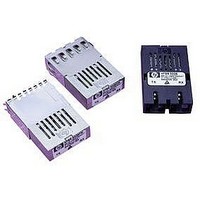HFBR-5205 Avago Technologies US Inc., HFBR-5205 Datasheet - Page 7

HFBR-5205
Manufacturer Part Number
HFBR-5205
Description
Fiber Optics, Transceiver Module
Manufacturer
Avago Technologies US Inc.
Datasheet
1.HFBR-5205.pdf
(21 pages)
Available stocks
Company
Part Number
Manufacturer
Quantity
Price
Company:
Part Number:
HFBR-5205
Manufacturer:
AVAG
Quantity:
5 069
Part Number:
HFBR-5205
Manufacturer:
AGILENT
Quantity:
20 000
The following information is
provided to answer some of the
most common questions about the
use of these parts.
Transceiver Optical Power
Budget versus Link Length
Optical Power Budget (OPB) is
the available optical power for a
fiber optic link to accommodate
fiber cable losses plus losses due
to in-line connectors, splices,
optical switches, and to provide
margin for link aging and
unplanned losses due to cable
plant reconfiguration or repair.
Figure 4 illustrates the predicted
OPB associated with the three
transceivers series specified in
this data sheet at the Beginning of
Life (BOL). These curves repre-
sent the attenuation and
chromatic plus modal dispersion
losses associated with the 62.5/
125 m and 50/125 m fiber
cables only. The area under the
curves represents the remaining
OPB at any link length, which is
available for overcoming non-fiber
cable losses.
Avago LED technology has
produced 1300 nm LED devices
with lower aging characteristics
than normally associated with
7
these technologies in the industry.
The industry convention is 1.5 dB
aging for 1300 nm LEDs. The
1300 nm Avago LEDs are
specified to experience less than
1 dB of aging over normal
commercial equipment mission
life periods. Contact your Avago
sales representative for additional
details.
Figure 4 was generated for the
1300 nm transceivers with an
Avago fiber optic link model
containing the current industry
conventions for fiber cable
specifications and the draft ANSI
T1E1.2. These optical parameters
are reflected in the guaranteed
performance of the transceiver
specifications in this data sheet.
This same model has been used
extensively in the ANSI and IEEE
committees, including the ANSI
T1E1.2 committee, to establish the
optical performance requirements
for various fiber optic interface
standards. The cable parameters
used come from the ISO/IEC
JTC1/SC 25/WG3 Generic Cabling
for Customer Premises per DIS
11801 document and the EIA/TIA-
568-A Commercial Building
Telecommunications Cabling
Standard per SP-2840.
Transceiver Signaling
Operating Rate Range and
BER Performance
For purposes of definition, the
symbol (Baud) rate, also called
signaling rate, is the reciprocal of
the symbol time. Data rate (bits/
sec) is the symbol rate divided by
the encoding factor used to
encode the data (symbols/bit).
When used in 155 Mbps SONET
OC-3 applications the perform-
ance of the 1300 nm transceivers,
AFBR-5205Z is guaranteed to the
full conditions listed in individual
product specification tables.
Figure 4. Optical power budget vs. fiber optic
cable length.
12
10
8
6
4
2
0
0.3
FIBER OPTIC CABLE LENGTH (km)
0.5
AFBR-5205Z, 62.5/125 µm
1.0
AFBR-5205Z,
50/125 µm
1.5
2.0
2.5






















